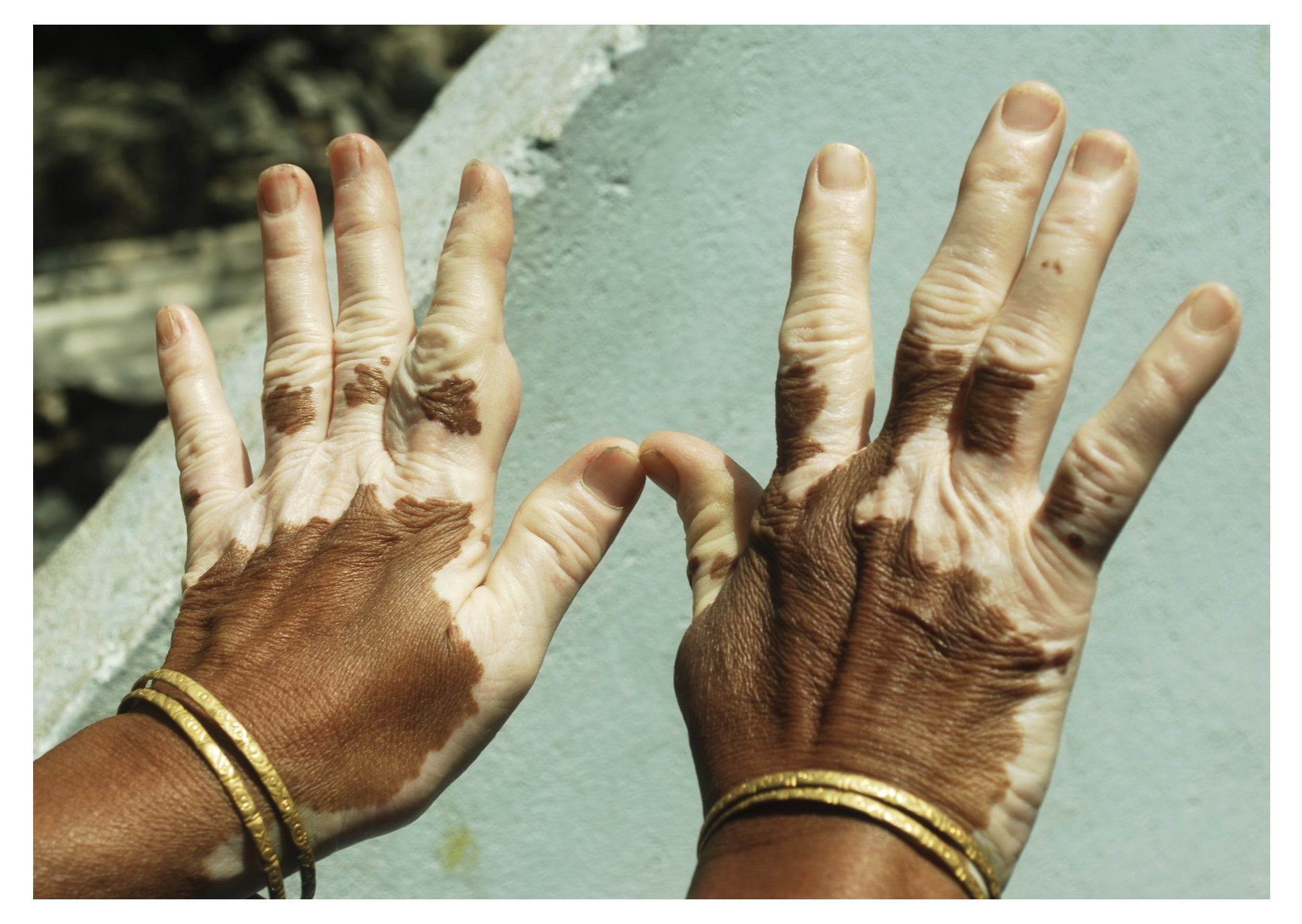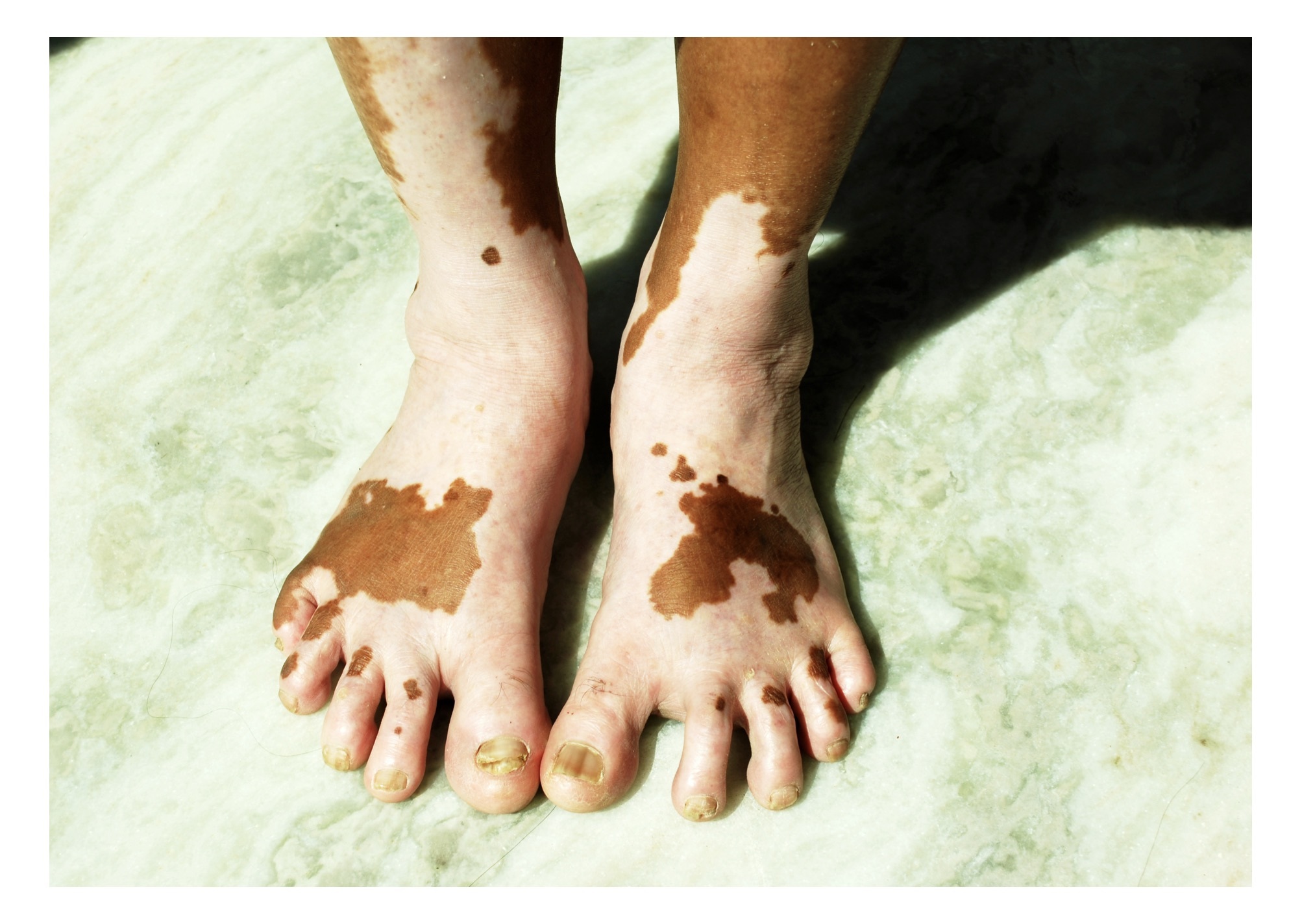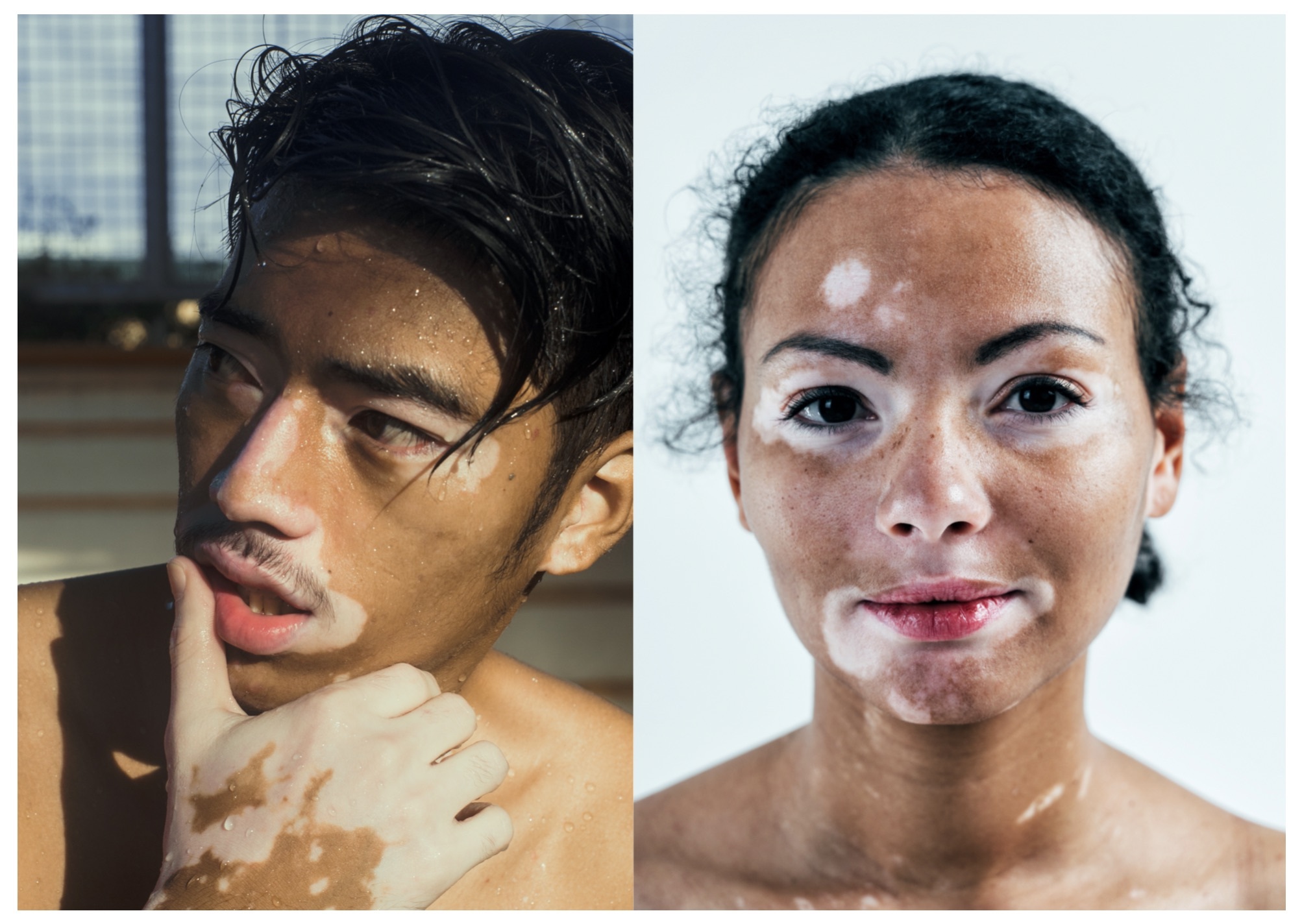Vitiligo
Notes
Overview
Vitiligo is an acquired depigmentation disorder due to the selective loss of melanocytes.
Vitiligo is a common, chronic skin condition that results in depigmentation due to the loss of cells known as melanocytes that are important in the production and distribution of the pigment melanin. It causes well-circumscribed areas of depigmentation leading to large areas of white skin.
Vitiligo can affect any race, but the condition is most striking in people with darker skin that can have a significant impact on quality of life and mental health. In most cases, it is a clinical diagnosis based on the characteristic finding of well-demarcated white macules or patches. Importantly, vitiligo is becoming increasingly accepted as simply a difference in appearance with less need to seek 'treatment' of the condition.

Vitiligo affecting the hands
Epidemiology
Vitiligo is the most common cause of depigmentation that affects up to 2% of the worlds population.
Vitiligo can affect both children and adults with an equal sex distribution. It may appear at any age but most commonly presents in the second to third decade of life with up to 80% of adults presenting before 30 years old.
Aetiology & pathophysiology
The exact cause of vitiligo remains unknown.
In vitiligo, there is selective loss of cells known as melanocytes that are situated in the basal layer of the epidermis. They are needed for the production of melanin that is a skin pigment, which gives the skin its characteristic colour. As well as the skin, it may be found in other pigmented tissue (e.g. iris, brain, adrenal gland).
In the skin, melanin is synthesised and packaged into melanosomes by melanocytes. Melanosomes are then transported to adjacent keratinocytes where they accumulate and shield DNA from UV light that would otherwise cause damage. Differences in skin colour are due to differences in the formation and processing of melanin rather than the number of melanocytes. These differences are related to the type of melanin and the number, size, and packaging of melanosomes.
The exact cause leading to the loss of melanocytes remains unknown, but several mechanisms have been proposed:
- Genetics: there is familial clustering of vitiligo (i.e. seen within families) and susceptibility genes have been identified (i.e. genes that increase the risk of developing vitiligo). Positive family history is seen in 25-30%.
- Autoimmune: vitiligo is associated with other autoimmune diseases (e.g. autoimmune thyroid disease, type 1 diabetes mellitus) and antibodies to melanocyte antigens have been identified in some patients.
- Oxidative stress: reactive oxygen species (ROS) are by-products of metabolism that can harm important cellular structures (e.g. proteins, nucleic acids). Oxidative stress occurs from an imbalance between the accumulation of ROS and the cells ability to detoxify them leading to damage. Increased oxidative stress may contribute to melanocyte destruction and melanocytes may even be more sensitive to oxidative stress created through their own synthesis of melanin.
- Other: several other mechanisms have been proposed for the development of vitiligo
Clinical features
The hallmark of vitiligo is the presence of depigmented macules or patches that have milk or chalk white colour.
Vitiligo may appear anywhere on the body. It is characterised by well-demarcated depigmented areas that have milk or chalk white colour. Commonly affected areas include the face (around orifices), genitals and hands. The areas are usually described as a macule or patch and may coalesce to cover large areas of skin.
- Macule: a flat lesion < 1cm in diameter
- Patch: a flat lesion > 1cm in diameter
The depigmented skin can follow pregnancy, severe sunburn, trauma or a period of emotional stress. In some cases, the hair roots can be affected leading to white hair or white eyelashes. Vitiligo may also show the Koebner phenomenon that refers to the development of the condition at sites of trauma (e.g. scratching, pressure, cuts, contact irritants).

Vitiligo affecting the feet
Distribution
Vitiligo may be classified into different types based on the distribution of the condition.
The initial two broad categories are:
- Non-segmental: most common, seen in 85-90% of cases. Non-dermatomal and divided into further subtypes based on the distribution
- Segmental: rare, usually occurs at an earlier age and shows a dermatomal distribution. Typically unilateral and may affect hair follicles in the affected dermatome
Non-segmental
There are various subtypes of non-segmental vitiligo based on the distribution of the depigmentation.
- Focal: small isolated area. Not evolved after 1-2 years
- Acrofacial: limited to the distal extremities and/or face
- Mucosal: oral and/or genital mucosa
- Generalised: typically bilateral and symmetrical over large areas of the body
- Universal: affecting at least 80-90% of the body. Typically preceeded by generalised subtype
- Follicular: depigmented body hairs
- Mixed: a combination of segmental and non-segmental forms

Vitiligo affecting the face
Diagnosis
Vitiligo is a clinical diagnosis based on the characteristic skin appearance of hypopigmentation.
The diagnosis of vitiligo can usually be made clinically by the presence of characteristic lesions. Wood’s lamp (a hand-held device that uses UV-A light to illuminate skin) and dermoscopy (skin surface microscopy) are useful bedside investigations that can aid the diagnosis in unclear cases.
In addition, patients should be screened for autoimmune thyroid disease. Screening for other autoimmune diseases may be warranted based on the history and examination.
Clinical course
Vitiligo is a highly variable condition and two patients may have a very different clinical course. Some areas of depigmentation may remain stable and slowly progress over time whereas others may progress rapidly. The distribution will commonly change over a persons' lifetime and the clinical course may alter between ‘flare-ups’ (i.e. progression of old lesions or development of new lesions) and stable disease (i.e. no detected change over 12 months).
Management
Treatments for vitiligo may halt the progression of the condition and cause a variable degree of repigmentation.
Vitiligo can be a sensitive condition and cause a lot of emotional distress. Treatments are available, but they may have limited efficacy, and will not be appropriate for all patients. It is important to focus on both the psychosocial aspects of the condition as well as the medical aspects.
Importantly, vitiligo is becoming increasingly accepted in society as simply a variation in appearance. It is not a life-threatening condition and more people are choosing not to undergo treatment.
The Vitiligo Society and Changing Faces charity are excellent websites and resources for people affected by vitiligo.
Conservative therapies
Patient education and support are vital in all cases. For mild cases, basic information on sun protection and avoidance of sunbeds may be all that is needed. Patients should be directed towards the vitiligo society and various charities.
People with vitiligo do not necessarily need to have any treatment, especially as modern society is much more accepting of vitiligo as a normal variation rather than a 'disease'.
Consider the following referrals if patients would like to undergo treatment:
- Skin camouflage service: use of specialist pigmented creams and powders to reduce the appearance of scars, marks, or skin conditions like vitiligo.
- Psychological services: if significant anxiety, depression, or other mental health problem related to their skin condition
- Dermatology: to consider medical therapies for vitiligo
Medical therapies
The choice of medical treatment depends on multiple factors including:
- Severity
- Distribution
- Activity
- Psychosocial impact
- Patient decision
Simple interventions can include a trial of potent topical corticosteroids over 1-2 months. However, this treatment is off-label and patients need to meet certain criteria. This type of treatment may not be appropriate for vitiligo affecting the face. More specialists interventions should be guided by dermatologists and referral is appropriate.
Specialist interventions may include:
- Topical therapies (e.g. steroids, calcineurin inhibitors): better for segmental or localised disease
- Systemic steroids (e.g. prednisolone): may be needed for widespread disease. May be combined with other therapies
- Phototherapy: narrow-band UVB phototherapy can be used but often requires long periods of treatment
- Systemic immunosuppression (e.g. methotrexate)
- Other: a number of adjuvant and emerging therapies may be available
Surgical options
Surgery may be an option for patients with stable, localised, depigmented areas if they have not responded to medical therapy. A variety of options exist including different types of skin grafts.
Prognosis
Vitiligo can be associated with significant psychosocial problems.
Vitiligo is considered a chronic and persistent skin condition, but the extent of the disease depends on multiple factors (e.g. age, distribution). The likelihood of spontaneous repigmentation is low.
The condition can be associated with significant psychosocial problems including low self-esteem, difficulty in social and sexual relationships, stigmatisation, anxiety, and many others. Finally, there may be a slightly increased risk of non-melanomatous skin cancer, particularly over depigmented areas.
Last updated: September 2021
Have comments about these notes? Leave us feedback
